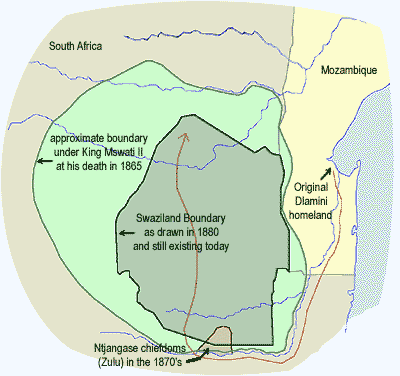|
| Search |
- Home
-
Tourism
- Tourism
- Visiting Swaziland
- Visiting SNTC Areas
- The Lubombo Route
- Interactive Maps
- Cultural Resources
-
Nature Reserves
- Nature Reserves
- Malolotja
- Hawane
- Mantenga
- Mlawula
- Other Protected Areas
- Proposed Reserves
-
Biodiversity
- Biodiversity
- Swaziland's Flora
- Swaziland's Fauna
- Research Projects
-
Programmes
- Programmes
- Park Management
- Education
- Community Outreach
- Research
- BCPD
- Wetlands
- TFCAs
- Legislation
| CULTURAL RESOURCES: Swazi History - Olden Times |
|
There is ancient evidence of humans in olden Swaziland, in caves along the Lubombo Mountains, especially at Mlawula Nature Reserve (Siphiso Rock Shelter), and at the Ngwenya Mines in Malolotja Nature Reserve (Lion Cavern). In historical times the land was home to nomadic San/Bushmen, who were later expelled or absorbed by various Nguni-, Sotho- and Thonga-speaking clans. The ruling Nkhosi-Dlamini family and other clans entered southern Swaziland about 250 years ago. They established the Swazi nation, either peacefully or forcefully absorbing the above clans. The Dlamini avoided military clashes with their powerful southern neighbours, firstly the Ndwandwe (Nxumalo), from 1800-1820, and later the Zulu, between 1820-1879. At the same time they expanded rapidly to the north and west, colonizing the Nelspruit, Carolina and Piet Retief Districts. The Boers and British appeared from the 1840s onwards. Avoiding conflict with the whites was a major policy,after king Sobhuza I's "dream" warned him to do so. At times the Swazi aided the British and Boers to overcome other ethnic groups. Three land deals with the Transvaal Boers (1846, 1855, 1866) from the Swazi point of view were made to overcome rebellious Swazi princes, and to provide protection from the Zulu. These deals resulted in the loss of roughly half the territory once ruled by the most powerful Swazi King, Mswati II(1845-1865). The Swazi saw the Zulus' refusal to allow white farmers, traders and missionaries to penetrate their land, leading to Britain's destruction of the Zulu monarchy in 1879. In the 1880s, King Mbandzeni granted numerous concessions to Boer graziers, and British traders and miners. This amounted to a "paper conquest" of Swaziland. After the Zulu War, the Swazis aided the British in dismantling the Pedi Kingdom. In gratitude, Britain promised the Swazis they would retain their independence. This was despite the "scramble for Africa" in the 1880s.  In 1886 the discovery of gold made the Transvaal the prime force in southern Africa. The Boers demanded British agreement to their expansion either north across the Limpopo (Rhodesia-Zimbabwe) or east through Swaziland (the road to the sea). Britain reversed its position on Swazi independence and by 1894 had allowed the Transvaal to establish control over Swaziland. (Information on gold mining - see Malolotja Gold Mines.) When the Anglo-Boer War began in 1899, Transvaal control disappeared. When the Anglo-Boer War began in October 1899, the Transvaal administration left Swaziland. King Bhunu died in December 1899, leaving his successor Mona (Sobhuza II) an infant of 5 months. |
QUICK LINKS Site Map Contact Links Reference Material Discussions Updates |
